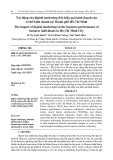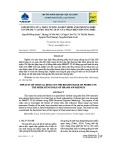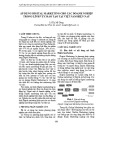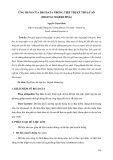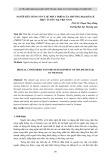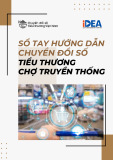
Số 11 (2023): 29 – 44
29
NGHIÊN CỨU YẾU TỐ ẢNH HƯỞNG TỚI Ý ĐỊNH MUA HÀNG TRỰC TUYẾN
CỦA NGƯỜI VIỆT NAM: MỞ RỘNG LÍ THUYẾT MÔ HÌNH CHẤP NHẬN
CÔNG NGHỆ (TAM)
Lê Thị Nương1*
1Trường Đại học Hồng Đức
* Email: lethinuongkt@hdu.edu.vn
Ngày nhận bài: 26/09/2023
Ngày nhận bài sửa sau phản biện: 24/11/2023
Ngày chấp nhận đăng: 15/12/2023
TÓM TẮT
Nghiên cứu khảo sát các yếu tố khác nhau ảnh hưởng đến ý định mua sắm trực tuyến của
người tiêu dùng Việt Nam. Mô hình chấp nhận công nghệ (TAM) được sử dụng làm lí thuyết
nền tảng để phát triển khung khái niệm nhằm kiểm tra ảnh hưởng của các yếu tố đến ý định của
người tiêu dùng đối với mua sắm trực tuyến. Nghiên cứu sử dụng bảng câu hỏi có cấu trúc để
thăm dò ý kiến của 468 người tiêu dùng về các yếu tố ảnh hưởng đến hành vi mua sắm trực
tuyến và dữ liệu thu được phân tích bằng phần mềm SPSS 20.0. Kết quả nghiên cứu cho thấy
ảnh hưởng xã hội có tác động mạnh nhất đến ý định mua hàng trực tuyến, tiếp theo là trải nghiệm
và cảm nhận tính hữu ích, niềm tin cảm nhận có tác động không đáng kể đến ý định mua hàng
trực tuyến, trong khi rủi ro cảm nhận có tác động tiêu cực đến ý định mua hàng trực tuyến. Kết
quả nghiên cứu là tài liệu quý giá để các doanh nghiệp trực tuyến xây dựng chiến lược kinh
doanh phù hợp nhằm thu hút nhiều khách hàng hơn.
Từ khóa: kinh doanh trực tuyến, mô hình chấp nhận công nghệ (TAM), ý định mua hàng
trực tuyến.
FACTORS INFLUENCING ONLINE PURCHASE INTENTION
AMONG VIETNAMESE: EXPANSION OF TECHNOLOGY
ACCEPTANCE MODEL (TAM) THEORY
ABSTRACT
The study investigated various factors influencing Vietnamese consumers' intentions
towards online shopping. The Technology Acceptance Model (TAM) was used as a foundational
theory to develop a conceptual framework to examine the influence of diverse factors on consumer
intentions toward online shopping. The study used a structured questionnaire to poll the opinions
of 468 consumers on factors affecting online shopping behavior, and the data obtained was
analyzed using SPSS 20.0 software. Research results show that social influence has the most
potent effect on online purchase intention, followed by experience and perceived usefulness;
perceived trust has an insignificant impact on online purchase intention, while perceived risk has
a negative impact on online purchase intention. The research results are valuable literature for
online businesses to develop appropriate business strategies to attract more customers.
Keywords: online business, online purchase intention, Technology Acceptance Model (TAM).

30
Số 11 (2023): 29 – 44
1. INTRODUCTION
The emergence of smartphones, mobile
communication devices, and other wireless
transmission technologies has made it
possible for consumers to make purchases
anytime, anywhere, and in various methods.
Online shopping has become a trend in recent
years due to the development of technology
and the superior values that online shopping
brings compared to traditional shopping
(Yoke Cheng et al., 2022). The benefits of
online shopping include saving time and
effort by diversifying choices so customers
can easily make the most optimal shopping
decisions in terms of quality and price,
payment and delivery methods, and after-
sales service. However, online shopping also
has limitations, such as consumers quickly
losing balance in shopping, sometimes
buying according to preferences and habits
but not having real needs, leading to waste.
In addition, shopping in a virtual
environment also concerns customers about
quality and delivery methods, which directly
affects online shopping intention (Aziz &
Wahid, 2018). Although the trend of online
shopping is increasing, there are still many
customers who need clarification and support
to buy online due to a lack of trust. Therefore,
research on online purchasing behavior in
today's time is vital. Many researchers have
also delved into the factors that promote
consumers' online purchasing behavior.
Specifically, Yoke Cheng et al. (2022),
Hatamifar et al. (2021), and Binh et al.
(2022) examined the increase in consumer
intentions toward online shopping. They
emphasized that there are many factors
affecting consumers' online purchasing
behavior in different contexts and
environments. Specifically, the study of
Yoke Cheng et al. (2022) showed that
perceived trust has a significant influence,
while perceived ease of use and perceived
risk have an insignificant influence on
people's online purchase intention. Shekhar
& Jaidev (2020) found that trust in social
commerce has been identified as a mediator
in the relationship between social commerce
constructs, perceived ease of use, perceived
usefulness, and intention to purchase.
In recent years, the technology acceptance
model (TAM) has been used by many
researchers to understand consumer shopping
behavior. TAM is a theory that explains the
factors influencing awareness and intention to
use technology. It is a model that predicts
customer attitudes and loyalty toward the
benefits and uses of information (Davis, 1989).
The current study examines the relationship
between factors in the TAM theoretical model
and consumers' online shopping behavior.
However, it adds several other factors, such as
perceived trust, risk, experience, and social
influence. There have been many studies
applying the TAM theoretical model to
evaluate factors affecting consumers' online
purchasing behavior (Heijden et al., 2003;
Hatamifar et al., 2021; Gunawan et al., 2023).
However, research is limited to the theoretically
proposed group of factors, including perceived
usefulness and ease of use. It has been proven
that there are many other factors related to
technology that have a significant impact on
online purchasing behavior; therefore,
expanding the TAM theoretical model in
researching people's online purchasing
behavior is needed. The results of the current
research will be the foundation for helping
administrators in Vietnam's e-commerce sector
come up with appropriate strategies to promote
consumers' online purchasing behavior.
2. METHODOLOGY
To evaluate the influence of factors on the
online purchase intention of Vietnamese
people, six main factors are considered:
Perceived usefulness, perceived ease of use,
perceived risk, perceived trust, experience,
and social influence. The questionnaire was
sent directly and via email to consumers in
Vietnam in the period from March to May
2023. 500 samples of questionnaires were
sent, and 468 valid questionnaires were
collected for analysis. Random sampling is
used to select respondents. Data were
collected using a 5-point Likert scale ranging
from strongly dissatisfied to strongly satisfied.

Số 11 (2023): 29 – 44
31
KHOA HỌC XÃ HỘI
Table 1. Variables of the study
Factors
Variables
Sources
Perceived
usefulness
Buying online saves time
Hatamifar et al.
(2021), Binh et al.
(2022), Yoke Cheng
et al. (2022)
Buying online helps save on travel costs.
Customers have many choices when shopping online.
There are many attractive promotions only available for online
purchases.
Perceived ease
of use
Using a smartphone to shop online requires little effort.
Hatamifar et al.
(2021), Binh et al.
(2022), Yoke Cheng
et al. (2022)
Online shopping applications are straightforward to use.
Online shopping applications are easy to understand and
straightforward.
The steps to order online are very simple.
Perceived risk
Buying online can put product quality at risk.
Yoke Cheng et al.
(2022).
Buying online can put personal information at risk.
Buying online can be financially risky.
Buying online may run the risk of delivery problems.
Perceived trust
Online shopping through mobile apps is reliable in Vietnam.
Hatamifar et al.
(2021), Binh et al.
(2022), Yoke Cheng
et al. (2022)
Online shopping through mobile apps is trustworthy in
Vietnam.
Online retailers provide reliable information and always keep
their promises.
In my future shopping, I will use mobile apps and trust them.
Experience
I bought products frequently through mobile apps.
Hatamifar et al.
(2021)
Mobile apps offer more than traditional shopping methods;
hence, I get more experiences and fun.
I am knowledgeable about using mobile apps before I
purchase anything.
Experience is an essential factor that helps me make an online
purchasing decision.
Social influence
Family, friends, and acquaintances introduced and encouraged
me to shop online.
Gunawan et al. (2023)
Before participating in online shopping, I read a lot of
information and reviews on e-commerce sites, forums, and
social networks.
Information in the mass media influences my online shopping
intention.
Sellers' feedback and other customers' comments on e-
commerce sites influence my online shopping decision.
Online purchase
intention
I intend to engage in online shopping soon.
Hatamifar et al.
(2021), Binh et al.
(2022)
I will introduce family and friends and post information about
participating in online shopping on my social media accounts.
I will use online shopping instead of traditional shopping.

32
Số 11 (2023): 29 – 44
The questionnaire is divided into two main
parts. The first part includes respondents'
information, and the second part looks at the
critical variables of this study such as
perceived perceptions, perceived ease of use,
perceived risk, perceived trust, experience,
social influence, and online purchase
intention. The questionnaire is adapted from
previous studies combined with interviews
and in-depth consultation with some experts
in online shopping in Vietnam. This study
applies multiple regression methods through
SPSS to analyze data (Table 1).
3. RESEARCH CONTENT
3.1. Literature review and hypotheses
development
3.1.1. The theory of Technology Acceptance
Model (TAM)
The Technology Acceptance Model
(TAM) is a theoretical model of technology
usage behavior introduced by Davis (1989).
This model explains how users evaluate and
use new technology. According to TAM,
users' technology usage behavior depends on
two main factors: Perceived usefulness and
Perceived ease of use. Perceived usefulness is
the degree to which users believe the
technology will benefit their work or needs.
Perceived ease of use is the degree to which
the user believes using the technology will be
easy and uncomplicated. According to TAM,
if users believe that technology will bring
value to their work or needs and that using it is
easy, they will use it (Hatamifar et al., 2021).
Due to appreciating the TAM model as a
solid theoretical foundation for evaluating
technology use behavior, many scholars have
used TAM to analyze technology application
behavior in many different cases (Hubert et al.,
2017). However, TAM is often a technology-
based model whose underlying structures do
not comprehensively promote diversity in
users' task environments; therefore, it needs to
be expanded to explain better innovative
technology adoption behavior (Schepers &
Wetzels, 2007). This study enhances the TAM
model by adding four additional constructs:
perceived trust, perceived risk, experience, and
social influence.
3.1.2. Online Purchase Intention
According to Lodesso et al. (2019),
intention is a factor that represents an
individual's ability to perform future
behavior. Behavioral intention precedes
actual behavior and is also a factor in
predicting whether the behavior will be
performed (Ajzen & Fishbein, 1980). In
other words, user behavior is influenced by
behavioral intentions (Davis, 1989).
According to Ajzen (1991), intention is
assumed to include motivational factors that
influence behavior, which are signs showing
willingness and effort to perform the
behavior. According to the theory of planned
behavior (TPB), the intention to perform a
behavior is influenced by attitudes toward the
behavior, subjective norms, and perceived
behavioral control (Ajzen, 1991). The
stronger the intention for a behavior, the
higher the likelihood that the behavior will be
performed (Ajzen, 1991). Online purchase
intention is a customer's intention to use
online channels such as websites and social
networks to purchase goods and services. In
e-commerce, online purchase intention is
when a customer wants to make a transaction
through a website to own goods and services
to satisfy their needs. According to Zhang et
al. (2020), online shopping intention is
consumers' willingness to purchase products
and services after they review related online
comments. Shi Wen et al. (2020) affirmed
that online shopping intention is inevitable
when consumers know the role of online
shopping. After the Covid-19 pandemic,
consumer awareness of online shopping
behavior has increased quickly. They shop
online not only for convenience and cost
savings but also because of safety concerns.
3.1.3. Proposed research model
According to Ajzen (1991), intention is
directly influenced by attitudes, subjective
norms, and perceived behavioral control.
Factors that motivate consumers to
participate in online shopping come from

Số 11 (2023): 29 – 44
33
KHOA HỌC XÃ HỘI
convenience, variety of products and
services, rich information, easy access, and
ease of shopping. According to Davis (1989),
online shopping intention is influenced by
perceived usefulness and ease of use. Al
Hamli & Sobaih (2023) show that product
variety, payment methods, and psychological
factors are three critical factors affecting
online shopping behavior, while convenience
and trust factors do not have a significant
impact on consumers' online shopping
decisions in the context of COVID-19. In
online shopping, consumers often face risks
such as financial risks, information security
risks, product risks, risks of not receiving
goods, and return policy risks (Tham, et al.
2019). Ventre & Kolbe (2020) found that
perceived usefulness influences trust and
online purchase intention, trust has an inverse
relationship with perceived risk and
influences positively in online purchase
intention, while perceived risk has no
relationship with online purchase intention.
In a specific context, depending on
consumers' awareness and perception of online
shopping and different research purposes,
factors affecting consumers' online shopping
intentions will be identified and selected.
Therefore, the determination of factors is quite
flexible, depending on the unique advantages
of each different market segment.
Based on the above theory, along with
related research works, this study examines
customers' online purchasing intentions
based on the TAM framework. However,
according to (Al-Hattami et al., 2023), the
original TAM constructs may need to
appropriately capture the essential beliefs
influencing consumers' online purchasing
behavior. Therefore, in the context of this
study, other essential factors need to be
considered to understand consumers'
engagement intentions better when making
online purchases. The current study extends
TAM by incorporating external factors such
as perceived trust, perceived risk, experience,
and social influence to evaluate Vietnamese
people's online shopping intentions. The
proposed research model is as follows
(Figure 1).
Figure 1. Conceptual framework
3.1.4. Hypotheses development
This study examines customers' intention
to purchase online based on the TAM
framework. Perceived benefits are one of the
key drivers of technology adoption on the
platform. Convenience is an advantage of
new technology that makes it easier for
customers to purchase through applications
(Davis, 1989). Although it is commonly
believed that ease of use is not as important
as perceived benefits, it has been consistently
shown that the experience of convenience
when using technology has a direct impact on
post-purchase behavior customers and
purchase intention through future technology
applications.
Although research on TAM provides
insights into technology use, it focuses on
perceived ease of use and perceived
usefulness as determinants of use or intention
to use. It ignores other external factors that
may act as determinants of (Igbaria & Iivari,






